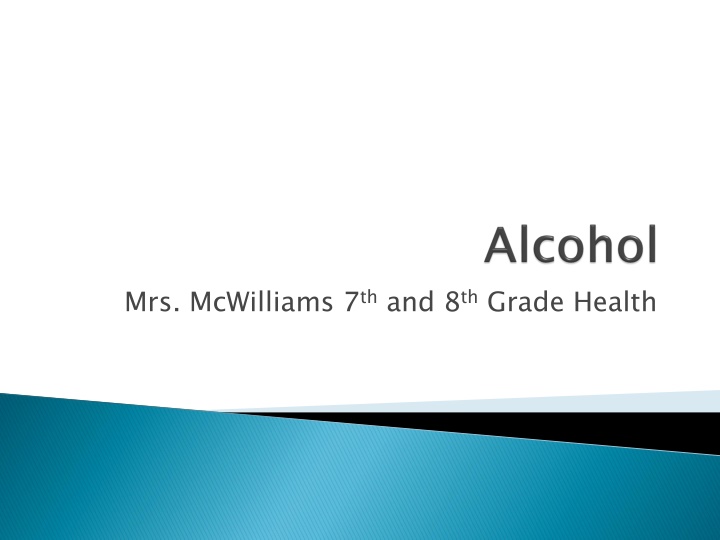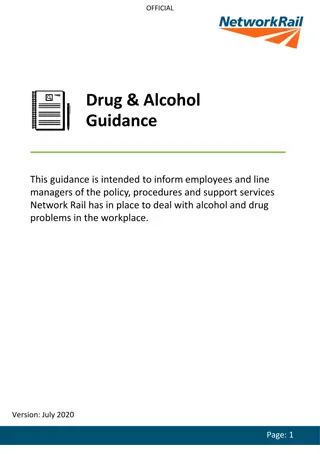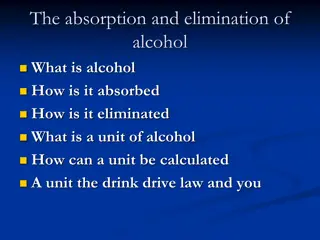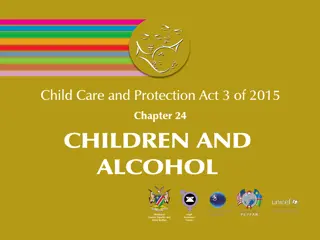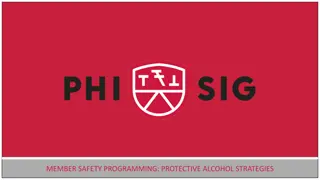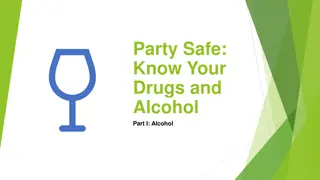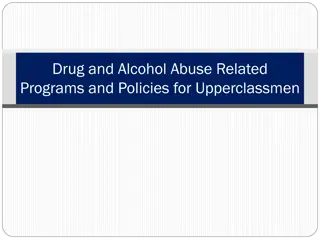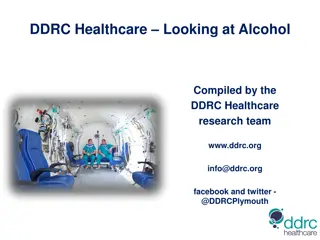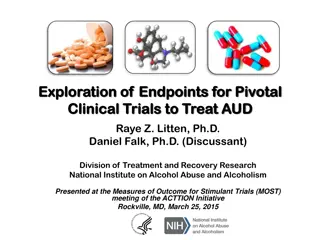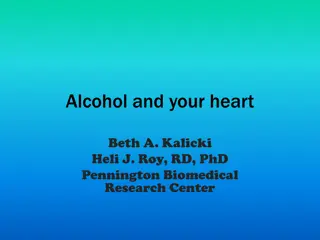Alcohol: Facts and Risks
Alcohol, a depressant, contains ethyl alcohol produced through fermentation. The proof value indicates alcohol concentration in beverages. Recommendations for daily consumption vary by gender. Statistics show varying drinking habits and the impact of heavy drinkers on alcohol consumption. Alcohol is rapidly absorbed, mainly in the small intestine, and metabolized in the liver. Strength of beverage, number of drinks, consumption speed, food presence, and tolerance affect intoxication. Blood alcohol percentage can be measured through breath or blood samples. Drinking alcohol impairs vision, reactions, and coordination, leading to serious consequences such as DWI/DUI accidents, especially among teens.
Download Presentation

Please find below an Image/Link to download the presentation.
The content on the website is provided AS IS for your information and personal use only. It may not be sold, licensed, or shared on other websites without obtaining consent from the author.If you encounter any issues during the download, it is possible that the publisher has removed the file from their server.
You are allowed to download the files provided on this website for personal or commercial use, subject to the condition that they are used lawfully. All files are the property of their respective owners.
The content on the website is provided AS IS for your information and personal use only. It may not be sold, licensed, or shared on other websites without obtaining consent from the author.
E N D
Presentation Transcript
Depressant Contains an intoxicating substance called ethyl alcohol or ethanol Produced by the fermentation process The anaerobic (no oxygen) conversion of sugar to carbon dioxide and alcohol by yeast.
The concentration of alcohol in a beverage is the proof value Proof value = 2X percentage alcohol. Example: 100 proof (whiskey) contains 50% alcohol
12 oz beer 5 oz wine Mixed drink with 1.5 oz of 80 proof liquor (40% alcohol) Current recommendations are: 1 drink/day for women 2 drinks/day for men
1/3 are abstainers 2/3 are drinkers 1/3 are light drinkers 1/3 are moderate/heavy drinkers 10% of the drinking population is considered heavy drinkers- they are responsible for 50% of all alcohol consumption in the US! Annual Sales of alcohol average out to roughly 2.3 gallons of absolute alcohol per person!
20% rapidly absorbed into bloodstream 75 % through upper part of the small intestine and the rest enters further along in the intestinal tract. Metabolism of alcohol is in the liver. 2-10% is not metabolized but is excreted through the sweat glands, lungs and kidneys.
Strength of the beverage Number of drinks consumed Speed of consumption Presence of food in stomach Physical tolerance
Percentage of alcohol in a measured amount of blood Measured from exhaled breath or blood sample
Drinking alcohol impairs vision, reaction time, and coordination. DWI and DUI leading cause of death among teens Signs of intoxication can begin to appear as low as 0.02 There is no acceptable BAC level for anyone under 21
Normal healthy liver Liver with cirrhosis
Fetus is exposed to alcohol in a slower manner than an adult Damage results in mental retardation Other characteristics are low birth weight, facial abnormalities, widely spaced eyes, and a much smaller head Full expression rate: 1-3 out of 1000 births Partial expression rate: 3-9/100 births
Regular daily intake of large amounts Regular heavy drinking limited to weekends Long periods of sobriety interspersed with periods of binge drinking lasting weeks or months Heavy drinking limited to periods of stress
A major factor in traffic accidents, homicides, and suicides for 16 to 24 year olds is a. alcohol use b. smoking cigarettes c. affiliation with gangs d. psychological disorders
Teens often choose to drink because they think it Increases their self confidence a. b. sharpens perceptions c. enhances memory d. improves judgment
a. Increases their self confidence
When a person stumbles and has difficulty walking after consuming alcohol, he or she has withdrawal symptoms a. b. is intoxicated c. has alcohol poisoning d. has a nervous system disorder
True/ False Food in the stomach allows a person to drink heavily without becoming intoxicated.
A physical and psychological dependence on the drug ethanol is Addiction a. b. Alcohol Poisoning c. Intoxication d. Alcoholism
True/ False The liver is responsible for breaking down alcohol.
A condition is which the liver tissue is destroyed and replaced with useless scar tissue is Fatty liver a. b. Arteriosclerosis c. Cirrhosis d. Fermentation
An inflammation or infection of the liver, sometimes caused by the toxic effects of alcohol is called Fatty liver a. b. Hepatitis c. Cirrhosis d. Fetal alcohol syndrome
True/False Some binge drinkers mistakenly believe that they are not really in trouble with alcohol because they do not drink every day.
The chemical action of yeast on sugars is Delirium tremens a. b. Ethanol c. Fermentation d. Hydrolization
True/ False Short term effects of alcohol use on the body can include cirrhosis and brain damage.
True/False A serving of beer or wine contains less alcohol than a serving of whiskey.
The first stage of alcoholism is characterized by Malnutrition a. b. Defensive behavior c. Rationalization of drinking behavior d. Reverse alcohol tolerance
c. Rationalization of drinking behavior
In the United States, fetal alcohol syndrome is the leading cause of Sudden infant death syndrome a. b. Mental retardation c. Alcoholic hepatitis d. Stillbirth
b. Mental retardation
True/ False The kidneys oxidize alcohol to form water, carbon dioxide, and energy.
